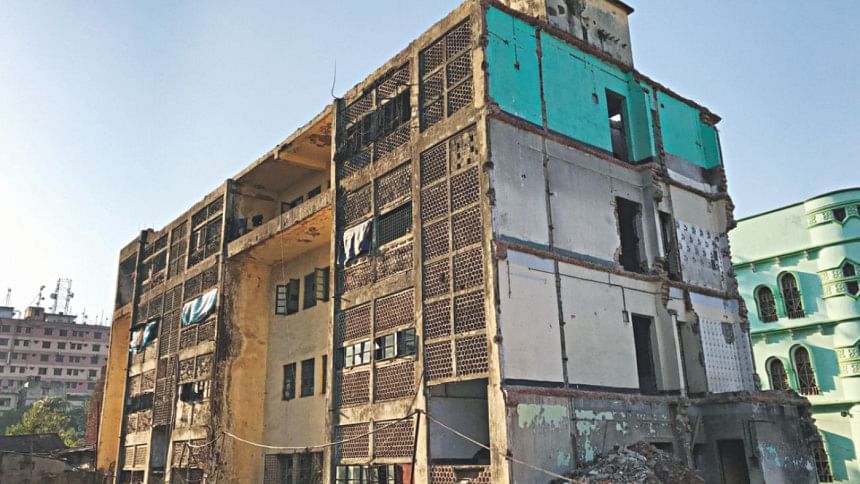A historical legacy at risk

If you commute regularly along the Azimpur Road, perhaps you have noticed the ongoing construction of multi-storeyed apartment buildings for government officials by the Public Works Department (PWD); there are good chances you have also noticed the knocking down of a few old four-storied blocks. Or, you may not have noticed it at all—after all, it's just another demolition work, the kind of which is taking place around every corner of this rapidly changing city. But as conscious citizens, we should know that the Azimpur Government Quarters is one of the earliest examples of public housing schemes in Bangladesh containing two notable specimens of residential quarters designed by the first Bengali modernist architect, the maestro Muzharul Islam. It's such a tragedy that we are demolishing these extraordinary buildings without paying due respect to the architect or his creation, without proper acknowledgement or recognition.
Some may ask, why should we remember him or even keep his works intact? Well, he was the only trained professional in the field of architecture in East Bengal back in the 1950s. Though he started his career as a civil engineer after obtaining his degree from Shibpur Engineering College, his longing for aesthetics and creativity led him towards architecture. But he also wanted to excel in that field. That is why he went abroad three times and finished every segment of his higher education in record time. Islam was taught at the University of Oregon (1952) through a Post-War Development Scholarship and later at Yale University (1961) under leading modernist architect Paul Rudolph through self-funding. He was also awarded the British Council Scholarship in 1956 for pursuing a post-graduate course in Tropical Architecture at the Architectural Association of London. Before starting his own practice in Dhaka, he worked as the Senior Architect of the Government of East Pakistan (1948-64) for 12 years intermittently in the Communication and Building Directorate (C&B). He was the founder president of not only the Institute of Architects Bangladesh but also the Institute of Architects Pakistan.
Although he is best known for his legendary works like the buildings of the Faculty of Fine Arts, the Central Library and the National Institute of Public Administration (NIPA) of Dhaka University, Chattogram University and Jahangirnagar University, there is a dearth of information on his hundreds of other projects including, but not limited to, residential buildings and other housing schemes. As very few of those structures have been explored or documented properly, many have faced the same fate like the Building Number 74 in the photo.
The four-storied building, which was originally designed as a three-storied structure, is situated on the southern block of the Azimpur Government Quarters, right beside the Azimpur Bus Stand Mosque and on the south-west corner of Azimpur intersection, where Dhaka has just started formulating a new urban fabric, emerging from the indigenous organic growth of Old Town. It is said that Azimpur was the residential area for the employees working under Subadar Azam Khan, the son of Mughal Emperor Aurangzeb, during the construction of Lalbagh Fort in 1678. The area became an outskirt of Dhaka during the British period, as illustrated in the map of 1859. There is no doubt that Azimpur was established as a residential area as early as 17th century and it got much prominence when Dhaka was declared as the capital of East Pakistan after the partition in 1947.
The construction work undertaken by the authorities included several commercial, institutional and residential area developments like Azimpur (1950s), Dhanmondi (1950s) and Wahab Colony (1956). Azimpur was the residential area for government officers. There were civil surgeons, engineers, administrative officers all sharing the same facilities like Azimpur Ladies Club, Azimpur Mosque and the Azimpur Maternity. Their children went to the same school and thus they became a part of the same neighbourhood like the mahalla in their childhood.
The whole Azimpur Residential Complex (with a few other four-storied buildings in the vicinity) was secured by a boundary wall before the demolition started. Every building had a number of single-bed apartments with a spacious living room, a small dining area, a moderate kitchen and lavatory with ample light and ventilation. The full-height window of the living room facing south allowed the breeze to come in through the built-in ventilators between the living and the dining space ,which also ensured privacy. The pre-fabricated jali or brise soleil (patterned concrete wall as sun-shading structure) on the balcony, a signature of the architect, plays with light and shade all day. They also hide the plumbing pipes and the clumsy kitchen accessories. The windows are well-protected by an alcove made of long extended roof and side walls; no added sun shades were attached—together, they act as a complete facade. There are adequate in-built shelves in cooking and sleeping spaces. The perfect arrangement for a bachelor government officer can also be a modest home for a single family.
Half of one of the two buildings is gone already. Three out of six apartments on each floor still remain, though the residents have been changing the original design for the last few decades. They are now being used as the temporary accommodation for the construction workers. Two out of three staircases are in usable condition. It's not too late to rebuild the whole structure or restore the existing portion to its original glory. It can stand there simply as an example of that period or of Muzharul Islam's design process for a comparative analysis.
The question arises, why should we preserve them? After all, it's just a block in that area! Well, we should remember that it was the beginning of planned housing projects in Bangladesh. The arrangement of rectangular buildings like in other government housing projects may seem rudimentary at present but it is a significant part of our architectural history in the context of Dhaka as well as the history of East Bengal. Only a few buildings of that time-span in the neighbouring countries resemble such examples.
It was such an innovative creation at that time that one of the buildings, Building Number 75, was known as Ajob Bari (the Strange Building) and people used to come to see it out of curiosity! Anonymously, a senior dweller of that building shared her personal experience, mentioning that it was designed basically for a bachelor officer. But she started living there as a newly married woman and stayed there longer than expected as her son became a government employee. Now she has two grandchildren, and all of them are staying in the same house without much hurdle. She agreed that it was much more comfortable when they were just two, but even now it is still liveable.
Muzharul Islam split the space of each unit into sections which helped to fulfil the functional requirements of the residents. Instead of arranging the sleeping, living-cum-dining spaces, kitchen and toilet horizontally in a similar pattern in all the modules, he grouped them vertically and created a duplex in a single building block. His organisation of volume here had been deeply influenced by the concepts of esteemed architect Le Corbusier. The structure contains 20 interlocking duplex units; 10 of them can be accessed from the ground level and the rest from the upper floor. There are two wide staircases connected by a corridor for circulation and which also serve as a community space. Neighbours shared their stories and created collective memories on the corridor. Muzharul Islam realised that as a common Bengali practice, most of the doors of the dwellings would be kept open, so the corridors worked as an extended living space for the dwellers. They may have felt like an extended family living in their ancestral home with a courtyard.
Therefore, the two buildings are rare examples of solving the complexity of public housing in two different manners. They can feed the inquisitive mind of the future generation, ranging from architects to designers to planners to researchers. Also for unfolding the history of the transformation and architecture of Dhaka, these must be preserved as key representatives of modernist buildings in the city from that period of time. Thus, the half-demolished Building Number 74 should be restored and kept intact with proper conservation, and Building Number 75 should be protected from the current onsalught.
Fatiha Polin is Senior Research Associate, Bengal Institute for Architecture, Landscapes and Settlements.
Dhrubo Alam is a technical consultant (transport) at the Dhaka Metro Preparatory Technical Assistance Project, Dhaka Transport Coordination Authority (DTCA).





Comments